Last Updated on January 5, 2024 by Greg Gillson
What are the most common birds in the United States, you query? I’m glad you asked. I researched this question just for you!
Here are the 34 most commonly seen birds in the United States, ranked by actual sightings data. This is a list of the most common birds, with pictures, for the United States.
[New! At the bottom of the page I’ve also added a link to pages that tell what are the most common backyard bird for each state. Be sure to check those out for your state.]
Most of these can be seen in your yard, flying over your yard, or in your neighborhood. In fact, most of these birds can be attracted with bird food and a bird bath.
The most common birds throughout the year in the United States are these:
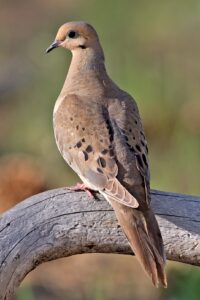
- Mourning Dove (35% frequency)
- Northern Cardinal (34%)
- American Robin (33%)
- American Crow (32%)
- Blue Jay (28%)
- Song Sparrow (25%)
- Red-winged Blackbird (25%)
- European Starling (25%)
- American Goldfinch (24%)
- Canada Goose (23%)
- House Finch (23%)
- Downy Woodpecker (23%)
- Mallard (22%)
- Red-bellied Woodpecker (20%)
- House Sparrow (19%)
- Turkey Vulture (19%)
- Black-capped Chickadee (19%)
- Tufted Titmouse (18%)
- Dark-eyed Junco (17%)
- White-breasted Nuthatch (17%)
- Northern Flicker (17%)
- Great Blue Heron (17%)
- Northern Mockingbird (16%)
- Carolina Wren (15%)
- Red-tailed Hawk (15%)
- Common Grackle (15%)
These bird species occur on more than 15% of all eBird checklists in the United States.
This page lists the most common birds in the United States as a whole, as determined by actual bird sightings reported to the citizen science birding program, eBird.
These birds are ranked according to frequency–the percentage of all bird checklists on which a species occurs. This does not mean they are the most numerous, however, but they could be. They are widespread, though, occurring in many habitats.
Seasonal lists of most common birds in the United States
While many of the most common birds are residents–staying in the same place throughout the year–some common birds are migratory or otherwise vary in abundance or detectability throughout the year. So here are two lists showing the changes in commonness during winter and summer.
Birds not on the top list of year-round common birds are noted below with an asterisk (*).
The most common birds in the United States in winter (December to January) are these:
Northern Cardinal (32% frequency)
American Crow (31%)
Dark-eyed Junco (29%)
Mourning Dove (29%)
Blue Jay (24%)
Downy Woodpecker (24%)
House Finch (23%)
European Staling (23%)
Canada Goose (21%)
Mallard (21%)
American Robin (21%)
American Goldfinch (20%)
Red-bellied Woodpecker (20%)
Song Sparrow (19%)
Tufted Titmouse (19%)
House Sparrow (19%)
Black-capped Chickadee (18%)
White-breasted Nuthatch (18%)
Red-tailed Hawk (18%)
*Yellow-rumped Warbler (17%)
*Ring-billed Gull (16%)
Northern Mockingbird (16%)
Carolina Wren (15%)
The most common birds in the United States in summer (June to July) are these:
American Robin (44% frequency)
Mourning Dove (40%)
Red-winged Blackbird (32%)
Northern Cardinal (31%)
Song Sparrow (29%)
American Crow (29%)
American Goldfinch (27%)
*Barn Swallow (24%)
Blue Jay (24%)
European Starling (22%)
House Finch (21%)
Common Grackle (21%)
House Sparrow (20%)
*Gray Catbird (19%)
*Common Yellowthroat (19%)
Turkey Vulture (18%)
*Brown-headed Cowbird (17%)
*Chipping Sparrow (17%)
Downy Woodpecker (17%)
Great Blue Heron (16%)
*Tree Swallow (16%)
Mallard (15%)
Black-capped Chickadee (15%)
Northern Mockingbird (15%)
House Wren (15%)
Northern Flicker (15%)
Photos and identification of the most common birds in the United States
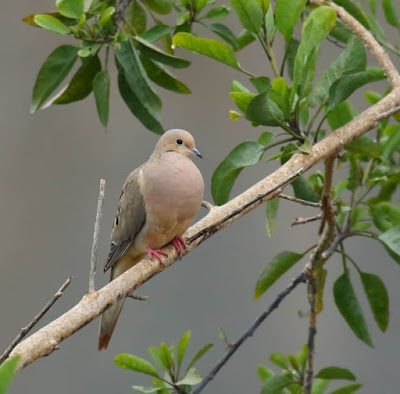 |
|
Mourning Dove, the most common bird year-round in the United States.
Photo by Greg Gillson
|
1. Mourning Dove (frequency: year-round: 35%, winter: 29%, summer: 40%)
Mourning Doves are the most widespread and most frequent backyard bird in the Lower 48 states of the United States.
Identification: This is a key species for comparing with an unknown bird. Size: About 12 inches long from bill tip to tail tip. About same size as Northern Flicker. Larger than American Robin. Slightly smaller than domestic city pigeon. Shape: Very plump with a small round head. Tail is long and pointed. Legs are short. Bill: Small and rather slender. Color: Pale brown-pink body, darker wings and tail. White edges on side of tail.
Habitat, range & behavior: Semi-open areas such as urban areas, farmlands, woods. Often seen perched on wires, fences. It is a resident across the lower-48 states and Mexico, with some movement out of northern areas in winter. Their mournful cooing is a familiar spring birdsong.
Food and feeder preference: Mourning Doves eat seeds almost exclusively. Attract with black oil sunflower seeds on a large sturdy tray feeder or on the ground.
2. Northern Cardinal (year-round: 34%, winter: 32%, summer: 31%)
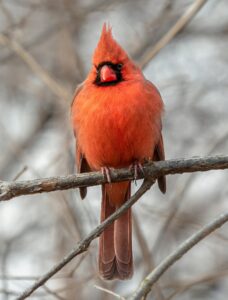
This is one of the most common and popular backyard birds in the eastern half of the United States.
Identification: Size: Cardinals are a bit smaller than American Robins, about the same size as Red-winged Blackbirds. Shape: Plump body with fairly long full tail. Wispy crest. Bill: Short, heavy, conical, pink. Color: That bright red color is matched by few other birds. Black face. The female is more gray, but with hints of red in wings and tail, and has a crest, too.
Habitat, range & behavior: Cardinals are year-round residents in shrubby woodland edges from the eastern United States to Texas and Arizona south into Mexico. That large conical bill is made for chewing seeds. Watch them crack open sunflower seeds, spit out the hulls, and pluck the kernel with their tongues!
Food and feeder preference: Black oil sunflower seeds. Many types of seeds, berries, nuts in larger hopper or tray feeders.
You may like my in-depth article on attracting Northern Cardinals.
3. American Robin (year-round: 33%, winter: 21%, summer: 44%)
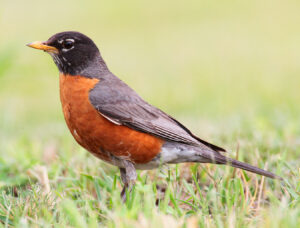
This familiar bird is a resident in the northern half of the United States and a winter visitor in the southern half.
Identification: This is a key species for comparing with an unknown bird. Size: 10 inches long from bill tip to tail tip. About the same size as a Blue Jay or one of the Scrub-Jays. Larger than Red-winged Blackbird. Smaller than a Mourning Dove. Shape: Very plump with a fairly long tail. Bill: Straight and fairly slender, curved at the tip. Color: Gray-brown upperparts, rusty orange breast.
Habitat, range & behavior: Open woodlands, farmlands, urban parks and lawns. Migratory, breeds north across Alaska and Canada. Resident in most of the United States (lower 48). Winters in the United States, Mexico, to central America. Hops on your lawn turning head this way and that looking for food. Their caroling song is one of the early signs of spring in the north.
Food and feeder preference: Worms and other invertebrates in the lawn. May eat fruit from a tray feeder or the ground. Eat small berries from trees and bushes.
4. American Crow (year-round: 32%, winter: 31%, summer: 29%)
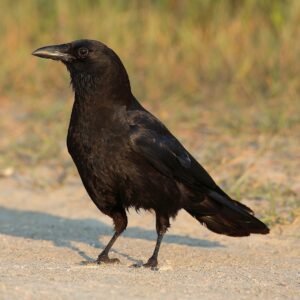
This larger all-black bird is common in cities and country. Its cawing call is familiar to most people.
Identification: This is a key species for comparing with an unknown bird. Size: About 17-1/2 inches long from bill tip to tail tip, though there is much size variation throughout its range. Larger than blackbirds and grackles. Smaller than ravens. Shape: Thick neck, large head, rather short square-ended tail. Longer legs. In flight has rounded wing tips with each primary feather separated from others forming “fingers.” Bill: As long as head, thick, black. Color: Glossy black throughout.
Habitat, range & behavior: They prefer open areas with trees, fields, farms, cities. They are common across most of the United States lower-48, except in the desert southwest. They move into southern Canada in summer. They gather in evening communal roosts in large flocks that may number into the thousands and then move out at dawn into the surrounding area.
Food and feeder preference: Omnivorous, they feed on large insects, grain, small mammals, carrion. You probably don’t want these large entirely-black birds in your backyard feeders. So don’t feed table scraps to birds.
5. Blue Jay (year-round: 28%, winter: 24%, summer: 24%)
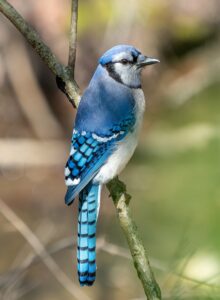
A common and well-known bird in the eastern half of the United States.
Identification: Size: About that of American Robin. Shape: Fluffy, large crested head, ample tail. Large strong legs. Bill: Black, long and stout. Color: Blue above, white below. Black neck collar. White patches in wing.
Habitat, range & behavior: Woodlands and towns in the eastern half of the United States. In summer into southern Canada. Bold and brash. May bully smaller birds. Jays gulp lots of seeds or other food at once, storing it in their crop. Then they fly off and bury food items in a hidden cache.
Food and feeder preference: Omnivorous. They can quickly empty your feeder! Because they are also aggressive toward other feeder birds, some people put mesh cages around smaller bird feeders. Small birds can go through, squirrels and larger “pest” birds are prevented entry. Some people feed jays peanuts, perhaps away from the seed feeders.
6. Song Sparrow (year-round: 25%, winter: 19%, summer: 29%)
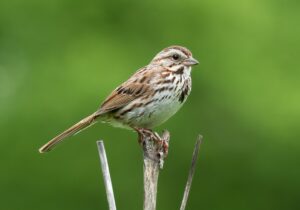
A common bird, but variable, and similar to many other streaked brown sparrows.
Identification: Size: A smaller bird, similar in size to House Finch and juncos. Larger than chickadees and goldfinches. Smaller than White-crowned Sparrows or Spotted/Eastern towhees. Shape: Plump with round head, long rounded tail. Bill: Short, conical. Color: Highly variable in darkness and color saturation across its range (dark rusty to pale gray). Generally gray-brown above with dark brown streaking on back. Complicated head pattern. Streaking on sides and breast converge into dense central breast spot.
Habitat, range & behavior: Thickets, especially near water. Backyard shrubbery. Resident in western United States, western Canada, coastal southern Alaska, northeastern US. In summer also moves into mid-Canada and northern half of US. In the winter found in most of the US lower-48. Also a population in central Mexico. Forages on ground, never far from low cover to which they fly if startled.
Food and feeder preference: They feed on seeds and insects near the ground. Will visit hopper and tray feeders for mixed bird seed.
7. Red-winged Blackbird (year-round: 25%, winter: 12%, summer: 32%)
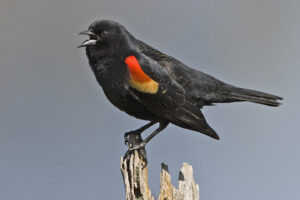
This very widespread bird sometimes visits bird feeders in winter. This is a marsh bird during most of the year. Flocks together with other blackbirds in non-breeding season.
Identification: Size: About the size of a European Starling, but longer tailed. Shape: Flat head, longer rounded tail, kind of pot-bellied. Bill: Medium, straight, slightly conical, sharply pointed. Color: Glossy black with red patch on wing bordered with yellow.
Habitat, range & behavior: Cattail marshes are the typical habitat. In winter more widespread, flocking into cattle feedlots, agricultural fields, and shopping center parking lots. Found primarily throughout the US and Mexico. Through most of Canada and into Alaska in summer. Males aggressively defend their nest area and will attack larger birds and dive bomb people.
Food and feeder preference: Seeds and insects, gleaned from the ground. Occasionally visit platform feeders in large flocks in winter emptying feeders, thus usually not encouraged in backyards.
8. European Starling (year-round: 25%, winter: 23%, summer: 22%)
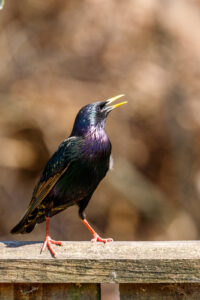
Introduced to North America in the late 1800’s, they crossed the continent, often to the detriment of native cavity-nesting birds. The prime example of an invasive species.
Identification: This is a key species for comparing with an unknown bird. Size: 8-1/2 inches from bill tip to tail tip. About the size of a Red-winged Blackbird. Smaller than an American Robin. Larger than a White-crowned Sparrow or Spotted/Eastern towhee. Shape: Stocky with large head, short square-ended tail. Longer legs. Bill: As long as head. Sharp pointed. Yellow in spring, otherwise dark. Color: They are grayish brown much of the year, with glossy iridescence and white spotting during the spring.
Habitat, range & behavior: Lowland birds that need trees large enough for nest cavities but plenty of open area for feeding. They are most abundant in urban and suburban areas where they find food and artificial nest cavities. Resident from coast-to-coast from southern Canada to northern Mexico. In summer north across Canada and Alaska. Native range is Europe to Pakistan, north Africa. Often viewed as a pest, starlings often bully other backyard birds, taking over bird feeders, and stealing nest cavities from smaller native birds. In winter they can form into flocks of ten’s of thousands.
Food and feeder preference: Primarily insects when available, often feeding on the ground. Discourage them from your backyard hopper and tray feeders by never feeding birds table scraps (including bread or meat). They have weak feet and do not perch well on tube feeders. A cage mesh around smaller hopper feeders may keep them out.
9. American Goldfinch (year-round: 24%, winter: 20%, summer: 27%)
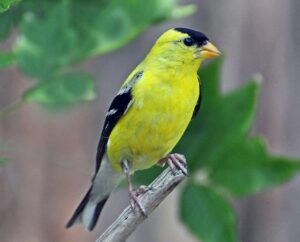
A beautiful tiny finch familiar to many in it’s bright yellow summer plumage. Colloquially called a “wild canary.”
Identification: This is a key species for comparing with an unknown bird. Size: Very small at about 5 inches from bill tip to tail tip. Similar in size to a chickadee. Larger than hummingbirds. Smaller than juncos and House Finches. Shape: Tiny, somewhat plump with larger head and short tail. Bill: Short, conical, pink. Color: Males in summer are bright lemon yellow with black forehead and black wings and tail with white bars. White under tail coverts. Females dull olive, wings and tail browner. Winter birds are pale grayish-yellow with tan and brown wings and tail.
Habitat, range & behavior: This species is found in weedy fields and similar clearings with thistles and similar plants. It is found coast-to-coast throughout the year across most of the middle lower-48 states. In summer moves north to the Canada border. In the winter found south to the Mexico border. The flight is highly undulating, rising and falling as they flap in short bursts. Besides a long, sweet lilting song, they call in flight a lilting 4-part: “potato chip!”
Food and feeder preference: Feeds on weed seeds, thistle seed. May eat black oil sunflower seeds from tube feeder. Love Niger seed in a feeder called a “thistle sock.”
10. Canada Goose (year-round: 23%, winter: 21%, summer: 13%)
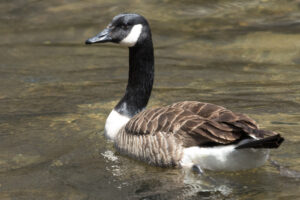
A widespread goose familiar to most from their loud honking in city parks and huge flocks that fly overhead in spring and fall.
Identification: Size: Larger waterfowl. Variable in size among many races, 30-45 inches long from bill tip to tail tip. Larger than ducks, smaller than swans. Shape: Powerful chest and longer pointed wings. Long neck, small head. Very short tail. Bill: Taller than width at base, narrowing toward the tip. Color: Brownish-gray above, white belly. Black neck with white chin strap. White rump contrasts with black tail.
Habitat, range & behavior: They live in marshes, grassy fields, tundra. They are found throughout most of Alaska, Canada, and the northern United States. In summer north into tundra. In winter throughout most of US, barely crossing into northernmost Mexico. Migrate in large noisy flocks in V-formation.
Food and feeder preference: Eat aquatic vegetation, grain crops, grass. Does not visit feeders.
11. House Finch (year-round: 23%, winter: 23%, summer: 21%)
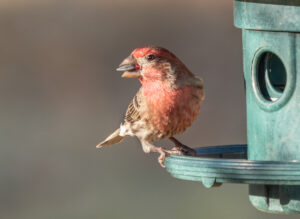
Here is California’s most common backyard bird. There are other red finches, but these are the ones most likely in residential areas.
Identification: This is a key species for comparing with an unknown bird. Size: About 6 inches from bill tip to tail tip. Larger than goldfinches and chickadees. Smaller than a White-crowned Sparrows or Spotted/Eastern towhees. Shape: Medium build with a medium-long notched tail. Round head. Bill: Short, conical. Color: Brown and gray above with streaks on the sides of the pale underparts. Males with red (sometimes orange or rarely yellow) crown, chest, rump.
Habitat, range & behavior: You’ll find small flocks on wires, in short tree tops and in bushes. Originally deserts and grasslands. Rural areas and towns are where they’re now most common. Formerly found in the western United States and Mexico. Then introduced into the northeastern United States, but now found in nearly all of the lower-48 states and extreme southern Canada. Rare in plains states (Dakotas to Texas) and southern Florida. House Finches are not territorial, but males sing throughout the year–a lively, wiry song ending in a couple of buzzy notes.
Food and feeder preference: They love sunflower seeds and tube feeders. May eat from thistle socks.
You may like my in-depth article on attracting House Finches.
12. Downy Woodpecker (year-round: 23%, winter: 24%, summer: 17%)
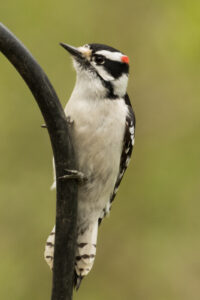
This tiny woodpecker is found across the United States.
Identification: Size: Bigger than a junco or House Finch. Smaller than a Red-winged Blackbird. About the same size as a White-crowned Sparrow, but with a much shorter tail. Shape: Stocky with large head and short stiff tail. Bill: Short, chisel-shaped. Color: Black-and-white striped head. Black wings with white spots. Solid white black. White under parts. Black tail with white outer tail feathers with black bars or spots. Male with small red spot at back of head.
Habitat, range & behavior: Found in small deciduous trees, willows, and even weed stocks such as teasel, especially near water. Ranges coast-to-coast across all but northernmost parts of Canada and Alaska south to the southern US. Absent in the desert southwest. Interestingly, I learned today that the males may more often be found in smaller plants and twigs, while females are more likely on tree trunks.
Food and feeder preference: Insects, fruits, and seeds. Gleans arthropods from the bark of trees. Attract with suet feeder. Will also eat black oil sunflower seeds.
13. Mallard (year-round: 22%, winter: 21%, summer: 14%)
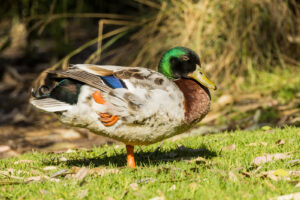
The world’s most well-known duck. Wild migratory birds join domestic resident flocks in winter. The wild Mallard is the origin of most domestic ducks. Domestic birds are often much larger, multi-colored, sometimes white and very tame.
Identification: Size: Larger duck, 23 inches long from bill tip to tail tip. Shape: Strong chest, short neck, big head. Short tail. Bill: Spatulate. Yellow on male, orange with black saddle on female. Color: Male gray above, paler below with chestnut chest and green iridescent head. Black under tail. Female camouflaged with brown mottling above, paler below. Both sexes show a colorful iridescent blue wing patch on the upper interior wing.
Habitat, range & behavior: Found in fresh water wetlands of all types, also estuaries. Widespread, it is found across most of North America, Eurasia, parts of Australia, north Africa. Females take care of nest duties alone. The well-known “quack!” is actually only given by the female. The male’s call is a softer squeaky “kreeep.”
Food and feeder preference: Eat snails and slugs, aquatic vegetation, grain. May eat bird seed (grains) spilled below bird feeders.
14. Red-bellied Woodpecker (year-round: 25%, winter: 12%, summer: 32%)
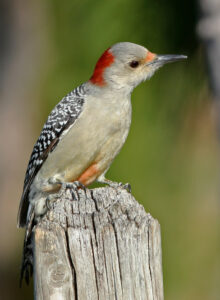
This is one of the most common species in the eastern half of the United States.
Identification: Size: Fairly large for a backyard bird. Between a Starling and American Robin in size. Smaller than a Northern Flicker. Shape: Stout with large head and short tail. Clings to tree trunk on strong short legs propped up with short stiff tail. Bill: Long, chisel-shaped. Color: Pale gray body, many thin black-and-white bars across back and wings. Red nape, extending forward on crown on male.
Habitat, range & behavior: These birds are found in many woodland types, including oak, hickory and pine. They are found from the eastern slope of the Rocky Mountains in the lower-48 states from Texas to extreme southern Canada, and eastward from Florida northward just to the southern edge of the New England states. In typical woodpecker fashion, it hitches up the tree trunk and larger branches.
Food and feeder preference: This species eats insects and nuts. They may eat peanuts from a tray feeder and eat from a suet block.
15. House Sparrow (year-round: 19%, winter: 19%. summer: 19%)
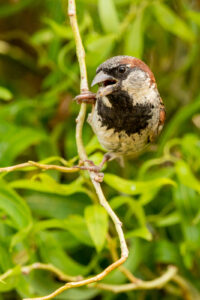
Like the starling, this is another bird introduced from Europe in the 1800’s. This sparrow is commonly found in cities and farmlands. It is considered a pest in most areas where it has been introduced.
Identification: Size: The size of a House Finch or Dark-eyed Junco. Shape: Chunkier than native North American sparrows with large head, barrel chest, short neck, medium tail, short legs. Bill: Short, conical. Color: Males are brown and gray with a black mask. Females lack the black and are tan and brown with a pale line back from the eye.
Habitat, range & behavior: Cities and farms. Range in North American from southern Canada through Central America. In summer northward through Canada to southern Alaska. Originated in Middle East and spread to most of Europe and Asia. Introduced in South America, Africa, Australia–nearly anywhere there are people and cities. They tend to be messy… and have a good appetite, and may occur in large noisy chirping flocks. They are aggressive toward other feeder birds.
Food and feeder preference: They eat grain, seed, and insects. To discourage them from your hopper and tray feeders do not feed birds human food scraps. They have a bit of difficulty eating from tube feeders.
16. Turkey Vulture (year-round: 19%, winter: 14%, summer: 18%)
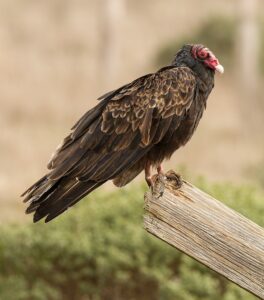
A well-known raptor seen feeding on carrion on the side of road, large fields.
Identification: Size: Large, 27 inches long from bill tip to tail tip. 69 inch wing span. Larger than Red-tailed Hawk, smaller than eagles. Shape: On ground a big body, long legs, long tail, tiny bare head does look very much like a turkey. In flight long rounded wings held in shallow V. Fairly long tail, appears nearly headless. Bill: Hooked, yellow. Color: Blackish-brown with silvery under flight feathers that contrast with darker wing linings. Adults have red heads, younger birds have black heads.
Habitat, range & behavior: Found in open country, shrublands, foothills, pastures, deserts. Resident from southern United States south through South America. In winter extend range northward to southern Canada. Glides unsteadily over open country. Searches for food–rotting meat by smell.
Food and feeder preference: Feeds on carrion. You don’t want one at your feeder!
17. Black-capped Chickadee (year-round: 19%, winter: 18%, summer: 15%)
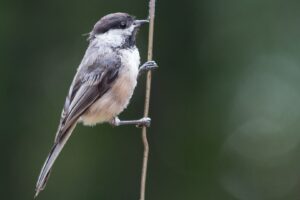
This is a common backyard bird in the northern half of the United States.
Identification: Size: Chickadees are small birds, the same general size as an American Goldfinch. Shape: Round body, big round head, long tail with rounded tip. Bill: Short, straight, stout. Color: Gray above, buffy below. Black cap and bib with white lower face. White edges on wing feathers.
Habitat, range & behavior: Deciduous and mixed forests. They range from the northern half of the United States, southern half of Canada, and most of Alaska. Small flocks flit actively from tree to tree acrobatically gleaning insects from twig tips. In winter chickadees make up the core of mixed-species flocks also containing nuthatches, kinglets, creepers, woodpeckers and others.
Food and feeder preference: Seeds, insects, berries. They eat at tube, hopper and tray feeders. They love black oil sunflower seeds and suet.
You may like my in-depth article on attracting Black-capped Chickadees.
18. Tufted Titmouse (year-round: 18%, winter: 19%, summer: 14%)
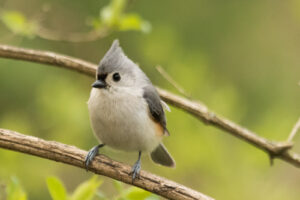
Related to chickadees, they lack the black bib, but have a crest instead.
Identification: Size: A small bird, but a large titmouse, this species is larger than chickadees, about the size of a junco or House Finch. Shape: Rounded body, long full tail, big head, long legs. Bill: Short and stout, compressed (taller than wide), black. Color: Dark blue-gray above, pale below. Black feathers around eye accentuates its size.
Habitat, range & behavior: Lives in deciduous forests with heavy canopy, parks. Found in eastern and southeastern United States is expanding its range north and west. Backyard bird feeders might be helping this species expand its range northward.
Food and feeder preference: Insects and seeds. At your hopper or tray feeder they like black oil sunflower seeds and suet.
19. Dark-eyed Junco (year-round: 17%, winter: 29%, summer: 6%)
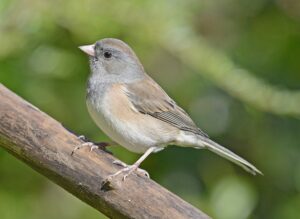
Colloquially called “snow birds,” they often arrive in backyards in winter from nearby mountain forests or more northern climes.
Identification: Size: Small birds about the size of a House Finch. Shape: Round body, short neck, round head, fairly long square-ended tail. Bill: Short, pointed, conical, pink. Color: Eastern birds are a darker all-gray with white belly. Western birds have jet black hood over head, brown back, and pink sides.
Habitat, range & behavior: Breed in coniferous forests. Winters widely. Avoids heavy brush, preferring widely spaced bushes. Breeds across most of Canada, Alaska, and the western half of the United States. Winters from southern Canada and all of the lower 48-states to extreme northern Mexico. Spend much of their time hopping and feeding on the ground.
Food and feeder preference: Eats mostly seeds, also insects in summer. Readily feed at backyard feeders on mixed seeds on hopper or tray feeders and ground.
You may like my in-depth article on attracting Dark-eyed Juncos.
20. White-breasted Nuthatch (year-round: 17%, winter: 18%, summer: 13%)
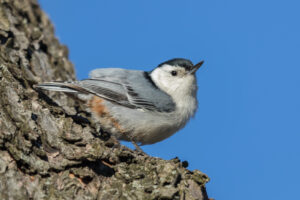
A favorite feeder bird for many for its active antics and fearlessness. Though a small bird it is the largest nuthatch in North America.
Identification: Size: About chickadee-sized in length. Smaller than a junco or House Finch. Shape: Appears large-headed, neckless, very short tailed. Short legs. Bill: Nearly as long as head, straight, thin. Color: Blue-gray above, white below. Black cap, wing tips, tail. Rusty feathers under tail.
Habitat, range & behavior: Common in oak and oak-pine woodlands, wooded towns. Found across the United States, southern Canada, mountains of central Mexico. Absent from treeless grasslands, deserts in the west. Crawls over tree branches and head-first down tree trunks searching for insects.
Food and feeder preference: Insects, seeds, acorns and other nuts. Love black oil sunflower seeds feeding on hopper and tray feeders. Suet blocks.
21. Northern Flicker (year-round: 17%, winter: 14%, summer: 15%)
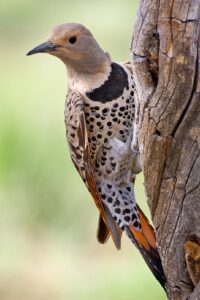
Of all the bird identification questions I get asked, this common larger backyard bird is the bird most people ask about. It doesn’t occur to those unfamiliar with it that this could be a woodpecker.
Identification: Size: About the size of a Mourning Dove. Larger than a robin. Shape: Stocky with short legs, short tail, big head. Bill: As long as head, thin, slightly curved. Color: Back is brown with black bars. Under parts pinkish with black spots. Undersides of black wing and tail feathers are bright salmon red (West) or yellow (East). Head gray (West) or brown (East) and males with red (West) or black (East) whisker marks and nape marks (East). Black crescent across chest. White rump seen in flight.
Habitat, range & behavior: Found in woodland edges and forests. Year-round resident from extreme southern Canada, across all of the lower-48 states and in the mountains of Mexico and Middle America. In summer breeds northward well into Canada and Alaska. Frequently noted hopping on ground pecking in the ground for insects. In late spring, males proclaim their territory by rapid pounding on a hollow tree branch, though the ringing of metal downspouts at dawn is louder and carries much farther, to the exasperation of anyone trying to sleep inside!
Food and feeder preference: Ants and beetles are their primary foods. Will eat black oil sunflower seeds and are attracted to suet.
22. Great Blue Heron (year-round: 17%, winter: 13%, summer: 16%)
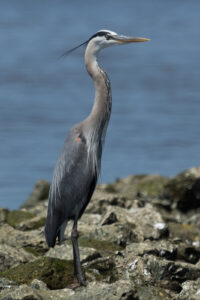
Colloquially sometimes called a “Blue Crane,” though cranes and herons are not closely related. Both do have long legs and necks, but have many differences.
Identification: Size: 46 inches long from bill tip to tail tip when stretched out. Wingspan is 72 inches, similar to the wingspan of the Turkey Vulture. Shape: Rather horizontal body and long snaky neck with s-curve. Long legs. very short tail. In flight flies with neck tightly kinked up against chest. Bill: Long, dagger-like. Color: bluish-gray above, paler below. Dull reddish neck. Black crown above white cheeks.
Habitat, range & behavior: Found in wetlands, meadows, marshes. Resident across most of the United States except mountains, deserts and northern prairie states. Along west coast to Alaska. In summer moves north into northern US prairie states and south central Canada. Walks slowly along wet ground or shallows stalking prey.
Food and feeder preference: Prefers small fish, also rodents, amphibians, small birds. Will visit your backyard fish pond to eat expensive koi. This is not usually considered a good thing, though.
23. Northern Mockingbird (year-round: 16%, winter: 16%, summer: 15%)
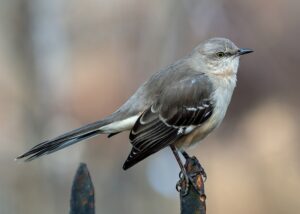
This bird sings from exposed perches most of the year and often through the night. They have an unending supply of their own unique short phrases that they repeat about 3 times each, but frequently intersperse songs of other birds.
Identification: Size: The length of an American Robin. Shape: Slender and long-tailed. Long legs. Bill: Medium length, slender, slightly curved. Color: Gray, darker above, with white patches in wing and tail.
Habitat, range & behavior: They prefer edge habitat with scattered trees and bushes, parks and residential areas. It is found in eastern and southern parts of the US, West Indies, and south into Mexico. In summer birds are found a bit farther north. They boldly defend their nests from other birds, cats, and intruders.
Food and feeder preference: Eats insects, berries, and fruit. You may attract mockingbirds to your feeder with grapes, raisins, apple slices. They will come to a suet block. They readily use a bird bath.
24. Carolina Wren (year-round: 15%, winter: 15%, summer: 13%)
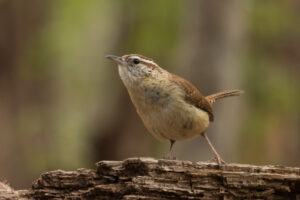
This is a fairly common backyard bird in the much of the eastern United States.
Identification: Size: A smaller bird, between the size of American Goldfinch and House Finch. Shape: Round body, short neck, flat head, long tail flipped about actively. Bill: Fairly long, thin, pointed and slightly curved. Color: Upper parts rusty brown with black bars on the wings and tail. A white eyebrow line and buff under parts.
Habitat, range & behavior: Shrubby thickets and brushy suburban yards. It is found in the southeastern United States and Yucatan. Northern parts of range expand and contract depending upon harshness of winters. Males sing throughout the year and are very loud for their size.
Food and feeder preference: Feed mostly on insects and spiders. They will feed on suet.
25. Red-tailed Hawk (year-round: 15%, winter: 18%, summer: 10%)
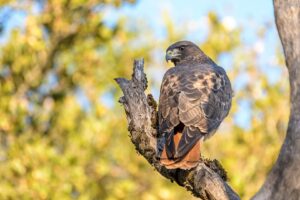
This is a widespread and well-known hawk in North America.
Identification: Size: A larger hawk. Length 23 inches from bill tip to tail tip. Wingspan 50 inches. Smaller than Turkey Vulture or eagle. Shape: Heavy body. Broad round-tipped wings. Wide tail. Strong feet with sharp talons. Bill: Fairly short and strongly hooked. Color: Usually dark brownish upper parts (sometimes reddish or blackish or sandy). Underparts generally pale with a barred band across the white chest. Underwing variable, but always showing a thin dark bar on the leading edge of the inner wing. Tail rusty as adult, barred brown in immature.
Habitat, range & behavior: Fields and open lands with scattered trees for perching. Resident across the lower-48 states, Mexico, Middle America, and along West Coast to coastal Alaska. In summer also across Canada and Alaska. Circles high in the air and rides thermals seeking prey.
Food and feeder preference: Rodents, rabbits, snakes. Do not eat at backyard feeders.
26. Common Grackle (year-round: 15%, winter: 4%, summer: 21%)
Sometimes considered a pest to crops, grackles are longer and lankier than very similar blackbirds.
Identification: Size: Larger than Red-winged Blackbirds, they are near the length of Mourning Doves. Smaller than crows. Shape: Long, with long full keel-shaped tail, long legs, flat crown. Bill: Longer than head, pointed, but stouter than other blackbirds. Color: Glossy black with hint of bronze or green on head (depending upon population). Yellow eye.
Habitat, range & behavior: They are found in agricultural areas, woodland edges, city parks and lawns. Resident in the southeastern United States. In summer they migrate northward and west to the central United States and Canada. They monopolize feeders and are bullies toward other birds.
Food and feeder preference: Grain, corn, acorns, small aquatic fish and amphibians. To discourage them, use tube feeders, rather than hopper or tray feeders. Don’t over-feed, keep spilled seed picked up.
27. Barn Swallow (year-round: 11%, winter: 0%, summer: 24%)
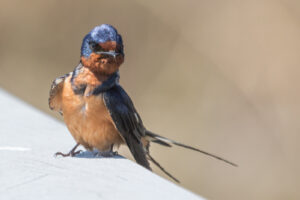
This is a cosmopolitan bird, chasing insects in most of the world.
Identification: Size: About the size of a House Finch. Shape: Very short neck, round head, long body, very long forked tail. Long wings. Very short legs. Bill: Short and wide, triangular. Hooked at tip. Color: Blue above, pinkish-orange below. Younger and winter birds paler below with shorter tail.
Habitat, range & behavior: Found in open country, farms, near water. Breeds in most of northern hemisphere, winters in tropics and southern hemisphere. Migrates across most of everything in between. Barely reaches main part of Alaska, northern Australia. Rare in northern half of Africa. Absent Greenland and extreme north. Chases insects low over the ground. Nests almost exclusively on manmade structures, such as rafters in barns or open garages.
Food and feeder preference: Feeds on flies and other flying insects, beetles, bees. Does not visit feeders. May gather mud for their nests from a mud puddle, but very rarely visit bird baths or artificial water features.
28. Yellow-rumped Warbler (year-round: 14%, winter: 17%, summer: 4%)
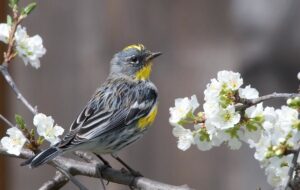
An abundant winter visitor in southern US to tree tops and weedy areas.
Identification: Size: Small, they are a bit larger than chickadees and goldfinches. They are smaller than House Finches and juncos. Shape: Plump and neckless with a shorter tail. Bill: Short, slender, straight, pointed. Color: Breeding plumage in spring is blue-gray on the upper parts, black sides and chest, yellow rump, yellow on sides. Two forms: western form with yellow throat and large white wing patch; eastern and northern form with white throat and two white wing bars. In winter plumage both forms are gray brown above, pale cream below. Yellow rump and white tail corners in flight.
Habitat, range & behavior: In breeding season mostly in coniferous or mixed forests, in mountains in west. In winter open areas with fruiting shrubs and scattered trees. Breed across Canada and Alaska and in conifer forests in the west. Winter along both coasts and the southern states through Middle America. There are also non-migratory forms in Mexico and Guatemala. They tend to forage in outer branches about half way up the tree.
Food and feeder preference: Mainly insects in the summer, they switch to waxy berries and fruit in winter. They are thus able to winter farther north than other warblers. They are attracted to suet feeders.
29. Ring-billed Gull (year-round: 12%, winter: 16%, summer: 6%)
 |
|
Ring-billed Gull
Photo by Greg Gillson
|
Possibly the most common widespread gull in North America. Adapted to human development.
Identification: Size: Medium sized gull, 17-1/2 inches bill tip to tail tip. Wingspan 48 inches. Shape: Typical gull shape, slightly pot belly, round head, short squared tail. Long thin pointed wings. Bill: Fairly long, hooked at tip. Color: Adults with silvery back and wings, rest of bird white. Bill yellow with black ring. Yellow legs. Pale eye. Immature very similar to other immature gulls, mottled brown plumage. Legs pinkish-gray. Dark eye. Bill shape and size of adults but pink-based with dark tip. Tail band on immature birds.
Habitat, range & behavior: Breeds near inland lakes in interior northern United States, southern Canada. Winters in agricultural areas near water, parking lots, fields. Moves south and coastally during winter through Mexico, Caribbean. Generally social; most often found in flocks.
Food and feeder preference: Scavengers that feed on animal and vegetable material. Find food in plowed fields, beaches, garbage dumps and urban shopping centers and fast food parking lots. Does not visit feeders.
30. Gray Catbird (year-round: 11%, winter: 2%, summer: 19%)
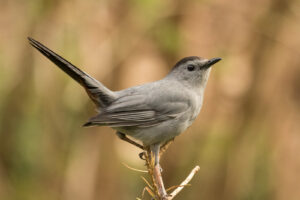
This bird is rather common where it occurs, but a bit secretive.
Identification: Size: About the length of a Red-winged Blackbird or Northern Cardinal. Shape: Long tailed, round head. Bill: Medium-length, pointed. Color: Gray with a black tail and black cap. Rusty under tail coverts.
Habitat, range & behavior: Dense woodland edges, scrub, abandoned orchards. Breeds in eastern and central US and adjoining southern Canada. Winters in extreme south US Gulf states, southward in eastern Mexico to Panama. They spend much time hopping on the ground or in low bushes. They defend a winter territory, unlike most birds.
Food and feeder preference: Insects and berries. You may attract this species with jelly and fruit feeders, suet, and water.
31. Common Yellowthroat (year-round: 10%, winter: 2%, summer: 19%)
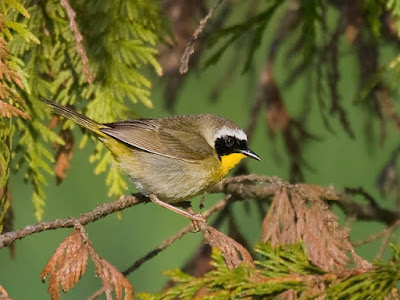 |
|
Common Yellowthroat
Photo by Greg Gillson
|
A small bird that hides in marshes and wet tangles. More often heard than seen. Has a loud “witchety-witchety-witch!” song.
Identification: Size: Small bird, the size of a goldfinch or chickadee. Shape: Fat round body, short neck, round head. Tail fairly long, rounded tip. Bill: Short, slender, straight, pointed. Color: Olive above, yellow below including under tail coverts and throat. Male with a black mask.
Habitat, range & behavior: Swamps. marshes, wet thickets. Breeds across most of Canada and the lower-48 states, and highlands of Mexico. Winters in extreme US south through Middle America. They forage low, gleaning from foliage.
Food and feeder preference: They primarily eat insects and invertebrates. Do not visit feeders, but may visit water features in backyards with heavy shrubbery to the ground.
32. Brown-headed Cowbird (year-round: 10%, winter: 2%, summer: 17%)
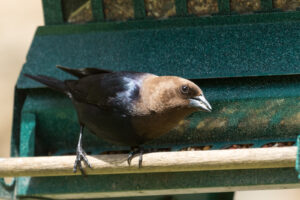
This is a small blackbird. Known for laying its eggs in smaller birds’ nests and having the smaller bird raise this giant offspring as their own.
Identification: Size: Medium-sized bird. Larger than White-crowned Sparrow or Spotted/Eastern Towhee. Smaller than European Starling or Red-winged Blackbird. Shape: Rather pot-bellied, small head, medium-long tail. Fairly long winged. Bill: Short, straight, conical, pointed. Color: Male glossy black with brown head. Females pale tan-brown throughout.
Habitat, range & behavior: Found in open areas with scattered trees. Breeds across southern Canada and most of the United States to northern Mexico. In winter retreats from mountain west and northern plains and extends into southern Mexico. Mixes in with flocks of other blackbirds in winter. May be found riding on cattle or walking about underfoot eating bugs stirred up by sheep and cattle.
Food and feeder preference: Feeds on seeds, grain, grasshoppers. Will occasionally visit seed feeders.
33. Chipping Sparrow (year-round: 10%, winter: 3%, summer: 17%)
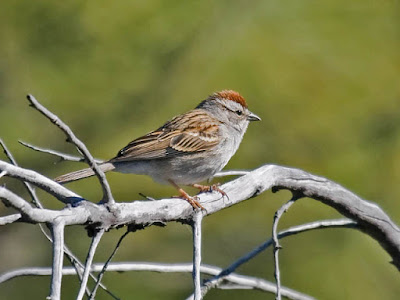 |
|
Chipping Sparrow
Photo by Greg Gillson
|
Identification: Size: Small sparrow. Larger than a goldfinch, but smaller than a House Finch. Shape: Rather thin, large head, medium tail with square tip. Bill: Short, conical, upper ridge (culmen) slightly curved. Color: Brown above striped with dark brown. Gray under parts and face with dark line through eye. Crown with rusty cap in summer, striped brown and gray in winter.
Habitat, range & behavior: Breed in open woodlands, orchards, conifer forests. Winter in more open weedy fields and grassy parks. Breed across Canada, United States, mountains of Mexico. Winter in the southern US and Mexico. Forage on ground. In winter form flocks of up to 50 birds.
Food and feeder preference: Eat mostly grass seeds, insects in summer. May visit backyard feeder, most often feeding on the ground on fallen seed.
34. Tree Swallow (year-round: 10%, winter: 2%, summer: 16%)
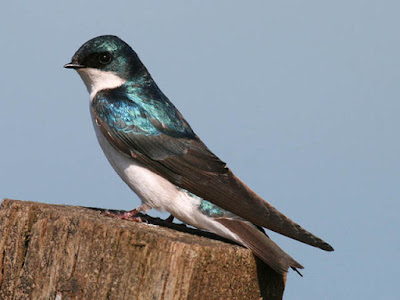 |
|
Tree Swallow
Photo by Greg Gillson
|
They readily take to nest boxes near water. They arrive very early in spring and grab nesting sites before many other resident birds that might use the boxes even begin nesting.
Identification: Size: Barely smaller than a House Finch. Shape: Long thin body with round head. Short tail. Short legs. Long wings. Bill: Short, wide, triangular. Color: Iridescent steel blue with black flight feathers. Black mask. White under parts.
Habitat, range & behavior: Find Tree Swallows near marshes and wet meadows. Breed north to tree line from Alaska and Canada south across the northern two-thirds of the United States. Winter along the southern border of the US, especially near coastline, south through Mexico and into Middle America. Adult Tree Swallows eat about 2000 insects per day (reference).
Food and feeder preference: Flying insects they catch in the air. Do not visit feeders.
The most common backyard birds of every state
(contiguous states only)
Here is a list to the common backyard birds in each individual state. Read about how to identify these birds at your feeder. Find out when they are most common in each season. Learn what to feed them to attract them to your yard.
- Common backyard birds of Alabama
- Common backyard birds of Arizona
- Common backyard birds of Arkansas
- Common backyard birds of California
- Common backyard birds of Colorado
- Common backyard birds of Connecticut
- Common backyard birds of Delaware
- Common backyard birds of Florida
- Common backyard birds of Georgia
- Common backyard birds of Idaho
- Common backyard birds of Illinois
- Common backyard birds of Indiana
- Common backyard birds of Iowa
- Common backyard birds of Kansas
- Common backyard birds of Kentucky
- Common backyard birds of Louisiana
- Common backyard birds of Maine
- Common backyard birds of Maryland
- Common backyard birds of Massachusetts
- Common backyard birds of Michigan
- Common backyard birds of Minnesota
- Common backyard birds of Mississippi
- Common backyard birds of Missouri
- Common backyard birds of Montana
- Common backyard birds of Nebraska
- Common backyard birds of Nevada
- Common backyard birds of New Hampshire
- Common backyard birds of New Jersey
- Common backyard birds of New Mexico
- Common backyard birds of New York
- Common backyard birds of North Carolina
- Common backyard birds of North Dakota
- Common backyard birds of Ohio
- Common backyard birds of Oklahoma
- Common backyard birds of Oregon
- Common backyard birds of Pennsylvania
- Common backyard birds of Rhode Island
- Common backyard birds of South Carolina
- Common backyard birds of South Dakota
- Common backyard birds of Tennessee
- Common backyard birds of Texas
- Common backyard birds of Utah
- Common backyard birds of Vermont
- Common backyard birds of Virginia
- Common backyard birds of Washington
- Common backyard birds of West Virginia
- Common backyard birds of Wisconsin
- Common backyard birds of Wyoming






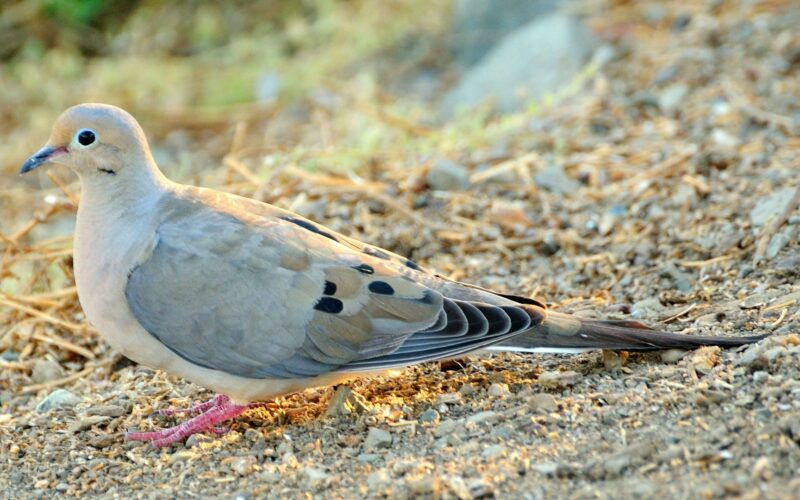
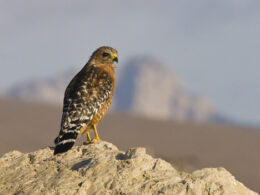
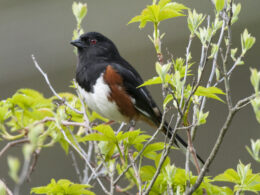
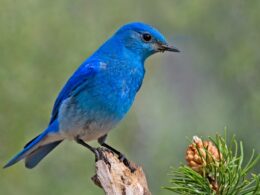
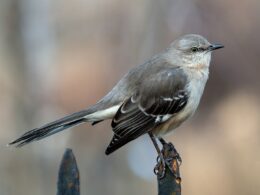
What does the asterisk mean? A common bird not on your Maryland list is the Gray Catbird, but it's only on your USA list – with an asterisk.
Thank you for visiting!
The asterisk is explained in the seasonal list. It means that the bird is common at one season, but not year-round.
As in this article on common USA birds, you will find Gray Catbird on the list of common summer birds in the article on common backyard birds in Maryland. It is not in the main list of common birds year-round.